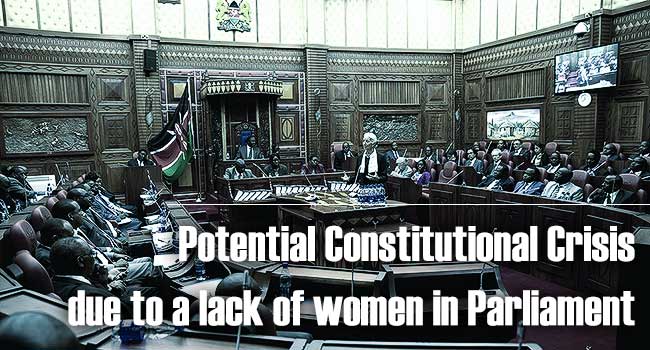Potential Constitutional Crisis Due To a Lack of Women In Parliament

Article 27 of the Constitution of Kenya 2010 recognizes that every person is equal before the law and has the right to equal protection and equal benefit of the law. The Constitution further espouses that women, youth, persons with disabilities and ethnic minorities are special groups deserving constitutional protection. Therefore the rights of women as being equal in law to men, and entitled to enjoy equal opportunities in the political, social and economic spheres cannot be refuted.
The Constitution obligates the state to take legislative and other measures, including affirmative action programs and policies to address the provision that 'not more than two-thirds of elective or appointive bodies shall be of the same sex'.
Article 97 of the Kenyan Constitution describes the composition of the National Assembly. Of its 349 seats, 290 are for those elected from Kenya's 290 constituencies, 47 are for women elected to represent each county, and 12 seats for nominated individuals to represent youth, persons with disabilities and workers.
Despite these affirmative action measures, women's participation in the 2013 general elections remained very low. There were 19 women candidates running for senatorial and gubernatorial positions (out of 237 candidates). None of them were elected for these positions. Of the 290 elected National Assembly members, only 16 women were elected, only 5 were nominated out of the 12 positions and 47 County women representatives bringing the total to 68 women out of the 349 seats (19.48%) falling short of 49 of the 117 required for full compliance with the two thirds gender rule. In the Senate there are 18 women filling the 18 reserved seats under the Constitution (26.8%) which is 6.4% short of the constitutional requirement out of the total 67 seats.
The government sought the Supreme Court's advisory opinion in order to forestall a looming crisis in the event that the two-thirds gender rule was not achieved. The Supreme Court advised that the two-thirds gender rule would be realized progressively as opposed to immediately. However the Parliament was given up to August 27, 2015 to come up with legislation on how the two-thirds gender rule will be met in the 2017 General Election.
There have been concerns about actualizing the two-thirds gender principle considering that we are past the Supreme Court deadline and the apprehension that it will be too expensive for the taxpayer, contributing to increased public spending. Additionally, the poor performance of women in the political arena has been largely hampered by the fact that the Kenya has been largely patriarchal.
In spite of this challenge, various working groups have come up with strategies that can be adopted to assist in the realization of the two-thirds gender principle. These are;
- Capacity building of women to enhance their engagement in the political life.
- Women to engage in cross party platforms as these are powerful avenues for uniting women beyond party lines and rallying them around a common agenda;
- A strong women's movement and political will;
- Women to register as members of political parties, seek leadership positions within parties, remain vigilant and participate in determining how party lists are drawn;
- Women to use their strength in numbers to compel political parties to adhere to the quota provisions; integrating the struggle for gender equity with the struggle for democracy;
- Women to identify male allies to help them lobby for the implementation of the quotas;
- Gender responsive civic and voter education to share information with women and the community at large on the need to have women take up leadership positions;
Further, we can have the Constitution amended in the following ways as suggested by the Green Amendment Campaign:
- Retain the current number of Constituencies at 290
- Increase the number of Women Members elected in Special seats to 136 up from the current 47
- The women MPs will be elected by the two adjacent Constituencies in each County in Counties with even number Constituencies; while counties with Odd number Constituencies will have the last three adjacent Constituencies
- County assemblies fixed in the Constitution at 1450. Remove nominations in the County Assemblies; instead have the two adjacent wards in each Constituency elect one woman making a total of 725 women elected on the special ward seats.
- Have a nomination of special interest groups to satisfy the 5% anticipated by the Constitution article 54 (2).
- Have each county elect two senators, one man and one woman.
- Have a sunset clause of 10 years on the special seats.
In the alternative, the number of Constituencies can be reduced to 210 and we can have each county elect two women as opposed to the current one, making a total of 94.
When compared to other countries in the East Africa region, Kenya has the lowest gender representation in political and governance structures and this calls for affirmative action, more effort and political will in order to ensure that the spirit and intent of the gender provisions are realized across all political and social structures. The role of key players including political parties, Civil Society Organizations and the media are should also be encouraged in contributing towards the realization of the two-thirds gender provisions.


